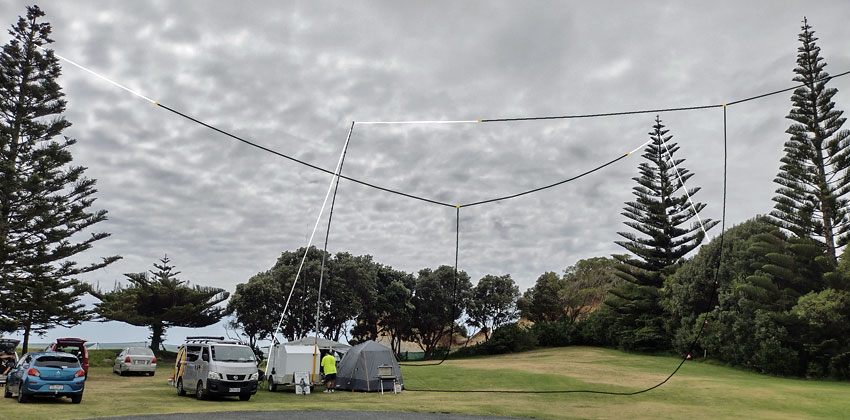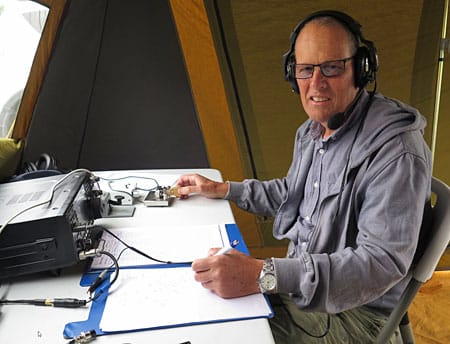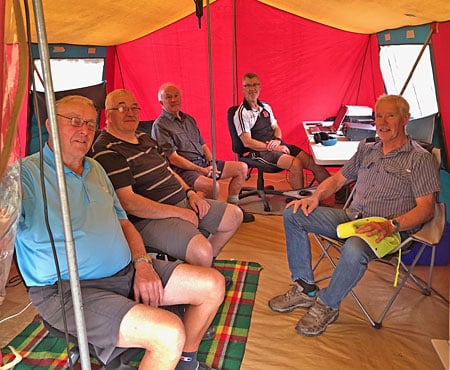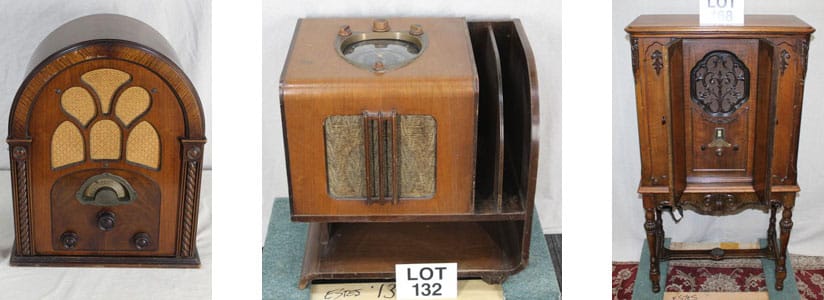This is a free fortnightly newsletter about the New Zealand Net.
If you would like to be notified by email when a new edition is published, please contact ZL1NZ.
Browse our Newsletter Archive and List of Net Tips.
Featured key

Photo: VK2IXV
By Herman VK2IXV
Only 200 of these keys were made in 1943 by the Dutch firm NSF/Philips in their German-controlled factory in Leuven/Belgium for the German Air Force (Luftwaffe). NSF stands for Nederlandse Seintoestellen Fabriek or Dutch Signal Apparatus Factory. Their HQ was in Hilversum/Netherlands. Philips and NSF were equal shareholders.
It is a lightweight key made of aluminium. Its lever is hollow and U-shaped with “Swiss cheese” holes to reduce its weight.
This type of key was not only used by the German Luftwaffe, but also by the Dutch resistance during the German occupation
* If you have an interesting key for this feature, please send a nice clear photo and a few words describing it.
Photo flashback

Eugen Gerald Marcuse 2NM (later G2NM) in his shack in the 1920s
Gerald Marcuse G2NM (1886-1961) was an active and influential radio amateur, conducting successful experiments in long-distance communication during the 1920s and becoming the first vice-president of the International Amateur Radio Union.
You can read about his remarkable radio achievements in this article by Peter Smith G4JNU.
And here’s one of Marcuse’s QSL cards of special interest for those of us in New Zealand:

Net numbers

NR7 R ZL1NZ 45/42 AUCKLAND 0800Z 1MAR24 = NZ NET = FEBRUARY QNI VK3DRQ 10 VK4PN 12 ZL1AJY 4 ZL1ANY 18 ZL1AYN 19 ZL1NZ 17 ZL1PX 7 ZL2AIM 9 ZL2GD 4 ZL2GVA 18 ZL2KE 8 ZL2LN 1 ZL2TE 16 ZL3TK 10 ZL4BDG 8 ZL4FZ 2 ZL4GW 2 ZL4KX 17 TOTAL 182 QTC 36 = ZL1NZ
Field Day reports from NZ Netters

ZL2AB. Photo enhanced to show aerials. Photo: ZL2TE
By Graeme ZL2TE
(New Plymouth Branch 27 ZL2AB)
Each February, the Jock White Field Day offers a unique set of challenges and experiences. From battling adverse weather conditions to troubleshooting technical issues on the fly, participants must adapt swiftly to overcome obstacles. The event also provides an invaluable opportunity for knowledge exchange, with seasoned amateurs sharing insights and novices gaining practical skills through hands-on participation.
Stations were permitted to be set up after 12:00 pm on Saturday. Operating began at 3:00 pm and the contest finished at 3:00 pm on Sunday. Yes there was a break from midnight to 6:00 am to get some sleep.
 Onaero Domain is a wonderful site where the Onaero River flows out to a small bay with a sandy, safe swimming beach and a good surf-casting spot. The domain is shared by a camp site and was the home of a surf club whose clubrooms have been dismantled. It is at that spot where we set up our camp. Two small tents joined by a gazebo formed our shelter with one tent dedicated to the 80 metre band and the other to 40 metres.
Onaero Domain is a wonderful site where the Onaero River flows out to a small bay with a sandy, safe swimming beach and a good surf-casting spot. The domain is shared by a camp site and was the home of a surf club whose clubrooms have been dismantled. It is at that spot where we set up our camp. Two small tents joined by a gazebo formed our shelter with one tent dedicated to the 80 metre band and the other to 40 metres.
The camp owners are great people and very supportive of the amateur radio activities, allowing us the use of toilets plus the use of the playground for the children of our participants’ families.
The photo above has been enhanced so that the aerials are visible against the grey sky. In the background is the 80 metre antenna with the 40m in the foreground. This year, rather than the fishing rod or bow-and-arrows of the past, we used a drone to fly a drawstring over the Norfolk pines used as masts for both aerials. It was fairly tricky flying conditions, with a brisk northerly trying to dictate where the drawstring was placed, but François was master of his machine.
Participants operated on the band of their choice, but unfortunately we had only one CW operator.
The rhythmic cadence of keying and the crackle of voices over the airwaves underscored the dedication and skill of those manning the stations. Notable was Ken ZL2KJT who “gave it a go”. Ken is one of the successful hams from the ham cram conducted last November and he took to it like a duck to water, running up a creditable score on his session.
Despite the gradual decline in participant numbers over the years, the enthusiasm and camaraderie among operators remained undiminished, creating an atmosphere of shared purpose and mutual support.
_…_
 By Gerard ZL2GVA
By Gerard ZL2GVA
(Marlborough Branch 22 ZL2KS)
The keys used were my Junker and my homemade paddles. I’m the only one using paddles in the club, so had to swap them between the 40 and 80m radios. The photo shows the 40m radio, an IC-7600. We used an IC-7300 on 80m. You noticed the much faster spectrum display on the 7300.
Comments on the CW: Operators were generally OK on sending, but not on procedures. Too many times they would send back our callsign (occasionally useful, but usually not needed). Or, instead of just sending their numbers, they would precede them with “UR NRS” and put an annoying “/” in between the groups.
Some took forever to answer a call (probably busy typing it into a computer and not knowing the keyboard layout 😉 ).
But, it was still better than on phone. I almost refused to do the phone sessions!
As an aside, I had two FM satellite QSOs, one via the ISS and one through AO-91. Both using my Boafeng 5W dual-band handheld and a 3-element tape-measure yagi. The one through the ISS was nice, because as it happened there were a few new members lounging around and it roused their interest! More so than two radio operators with headphones on. As I can’t hear myself back on the handheld I don’t use headphones and they could easily understand what was happening.
_…_
 By Grant ZL2GD
By Grant ZL2GD
(North Canterbury Branch 68 ZL3RR)
We were using N1NM software for log keeping and for sending on my IC-7300. Our antennas were end-on-end with a gap of 10m. There was a bit of a slope as it came down from an 80ft gum tree at one end to my 35ft mast at the other. It was sloping toward the West but we didn’t work any VKs this year, which was strange.
We had four CW ops in our team of six. I did most of the CW on 40 but Wayne ZL2AYB visited us and did a couple periods.
Pictured L to R: Geoff ZL3AL (80 CW), Don ZL3DMC, Wayne ZL2AYB, Geoff ZL3GA, John ZL3MR. Photo by Grant ZL2GD (40 CW).
What a shame there were so few CW stations on. I was only getting about 6-8 CW QSOs per hour – and often only seeing one or two stations calling at a time. The annual decrease in active CW branches is going to have a sad ending for us lot. We did recruit one new operator for Field Day, but he only knew the letter E.
This cocky rooster lives at View Hill domain. It appears that he has been abandoned and has taken up residence there.
He took a bit of shine to us and decided to join our team. I have no idea why we named him Phil but it seemed to suit him.
Someone wondered if he was attracted by the sound of CW, so we decided to see what his sending was like. Just as well we had an old straight key available.
We were in hysterics watching him. This helped fill in the time between QSOs. 🙂
Morse challenge
Here is a bit of the CWB Net from 30 March 2022. Your challenge is to tell me:
1) Who asked VK3DRQ to assume Net Control?
2) Who relayed the request to VK3DRQ?
Please send your answer via radiogram or email to ZL1NZ.
Answer to previous Morse Challenge
Jeff WB8WKQ sent the signal QSK (I can hear between my signals) so that ZM50MAUQ knew he could break-in at any time to request a fill while the traffic was being sent. CW traffic handlers typically use full break-in, as it makes operation faster and more efficient.
The correct answer was received from G4ETQ, VK3DRQ, ZL1ANY, ZL2GVA and ZL4LDY.
Dave ZL4LDY commented: “I used to work Jeff a lot on the NTS 8RN (8th Region Net) and EAN (Eastern Area Net) back when I had access.”
Indeed, Jeff is a sharp operator, as you can tell from the audio sample heard in the Morse Challenge. An interesting note: the traffic Jeff was sending originated in the UK and was destined for Australia, so WB8WKQ and ZM50MAUQ (aka ZL1NZ) were relay stations on this round-the-world QTC.
Vintage style

Photo: Cledis Estes Auctions
I’ve always loved the look of vintage broadcast receivers, especially those in wooden cabinets. Of course, back in the 1920s and 1930s, radios were big investments and appearances were important. Even so, it’s amazing how many different designs were produced, to help each manufacturer distinguish its products from myriad competitors.
Today I came upon an auction listing from the USA, featuring a collection of more than 200 radio items – mostly vintage broadcast receivers. It’s well worth a look.
In the middle photo above is a chairside radio. You can imagine sitting down beside it with your magazines and newspapers ready to peruse as you listened to your favourite station.
Video
Dave ZL4LDY has just acquired a CTR2-Micro, which he hopes will soon enable him to get him back on the air – and onto the NZ Net. 🙂
It looks like a pretty cool device:
Dave was one of the founding members of NZ Net, and it would be wonderful to hear his QNI again!
Advertising archive

ARRL: Radio Amateurs Handbook – 1957
Suggestions?
If you have suggestions on how to make the NZ Net better, or things you’d like to see covered in these updates, please contact ZL1NZ. You might even like to write something for the newsletter.
Thanks for reading, and I hope to hear you soon on the NZ Net!
—
Neil Sanderson ZL1NZ, Net Manager
New Zealand Net (NZ NET)
3535.0 kHz at 9pm NZT Mon-Fri




